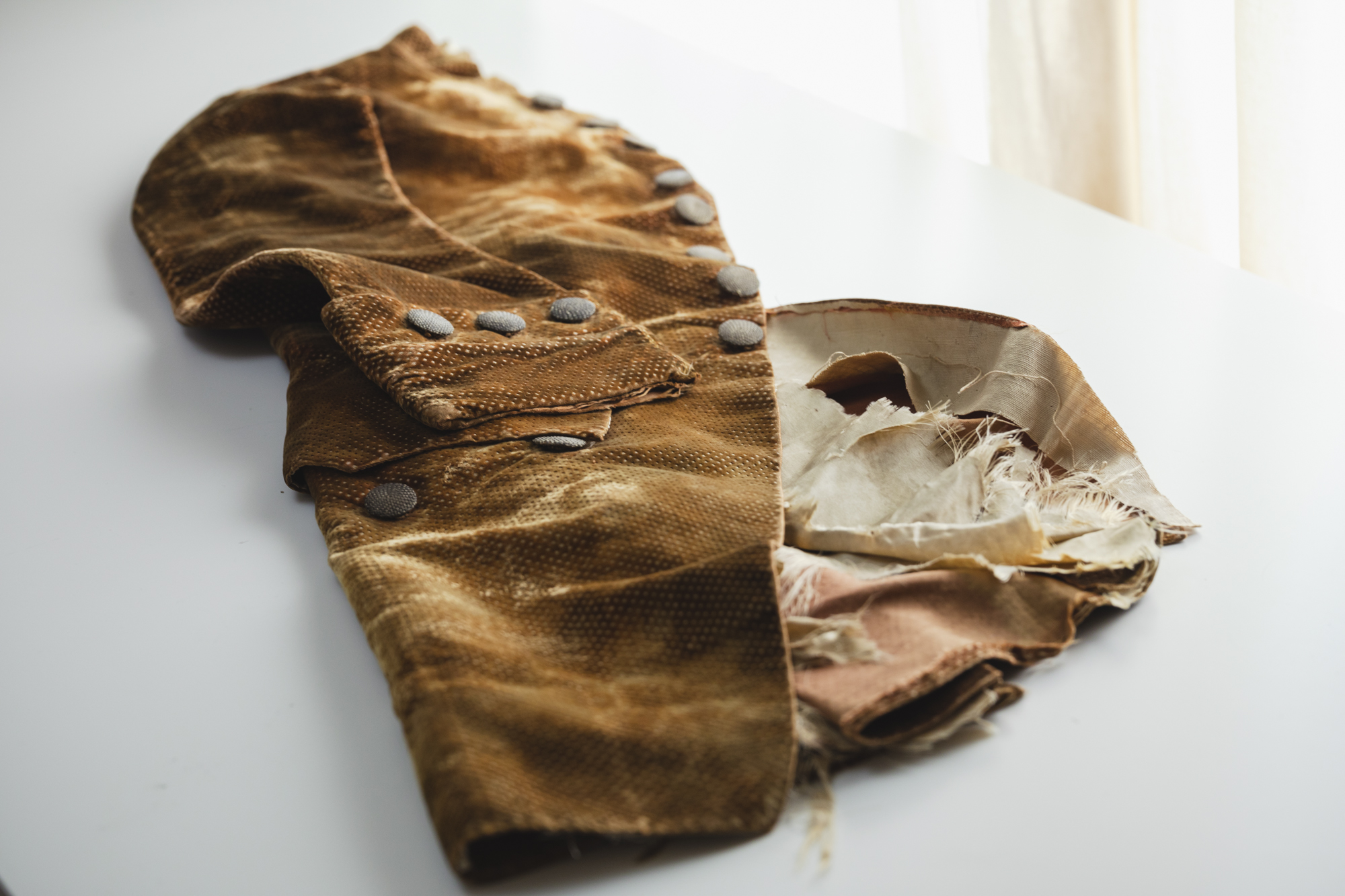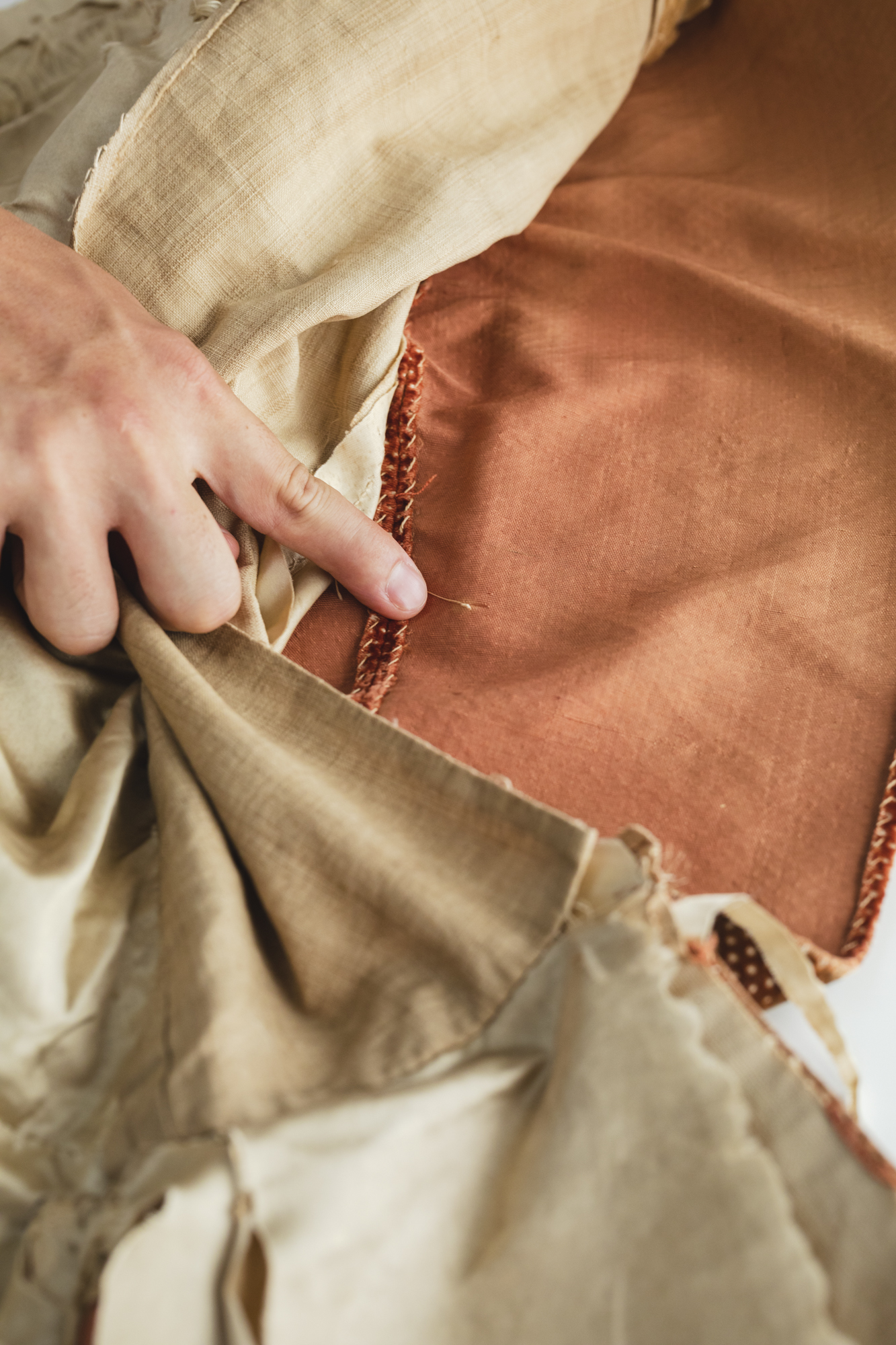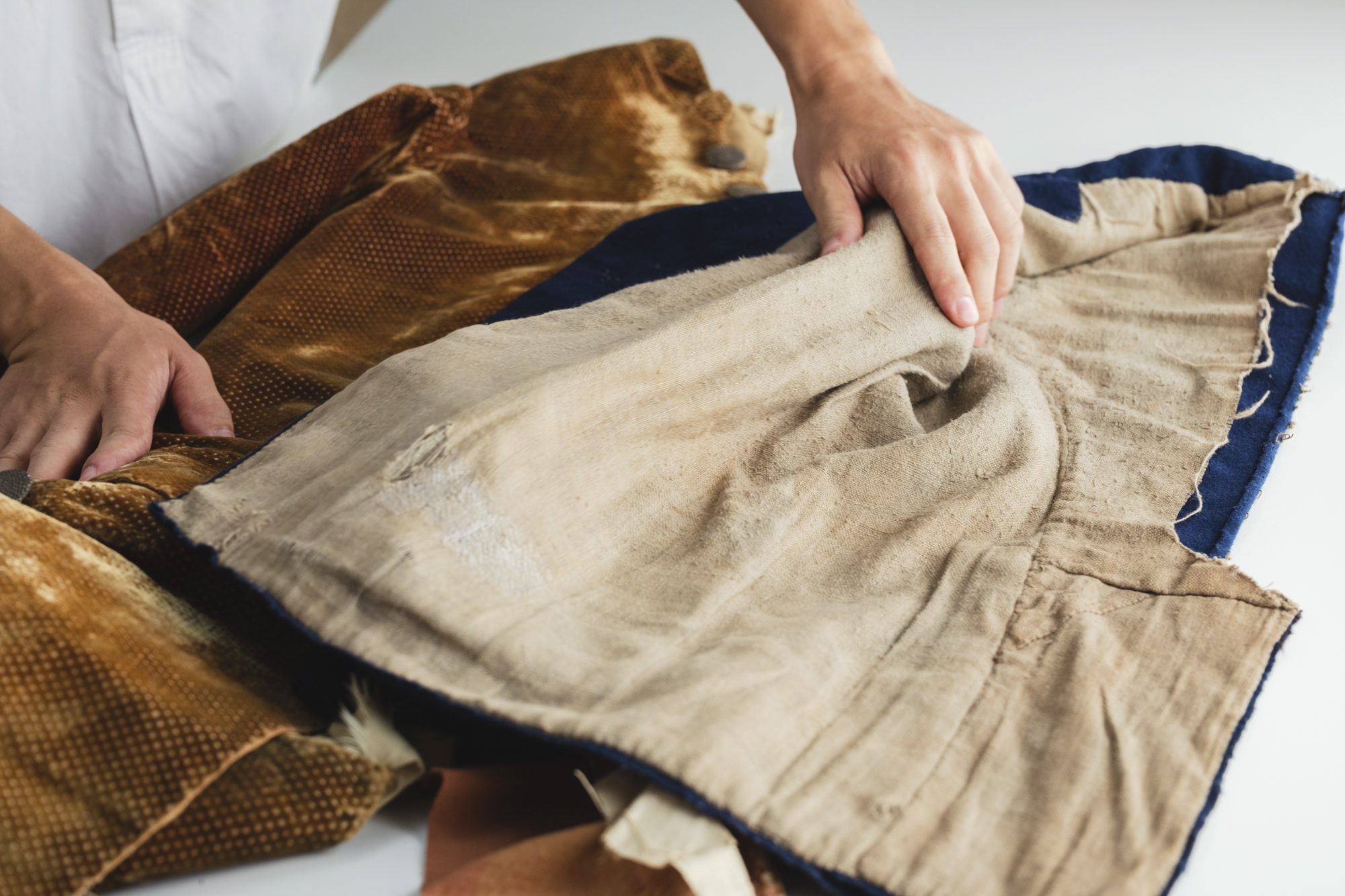Akira Hasegawa disassembles clothes from the French Revolution to WWII in half and creates samples/models from them. He is a “garment modelist” that strives to convey the emotions from a century ago, a century later. There aren’t a lot of modelists (people who create samples/models out of something) or designers deconstructing garments for research, and what sets Akira apart is his pursuit of the emotions that lie in these clothes.
His reconstructed clothes and clothing samples made from scratch were on display at his exhibition, Demi-Deconstruction. Visitors could not only see the clothes from 100 years ago but try them on too. He was planning on having another exhibition this May, but it got canceled because of coronavirus. In 2018, More than 2,000 people visited his exhibitions in Shibuya and Nagoya over 12 days, which cost 2,000 to enter. He had an ongoing exhibition at Isetan Men’s in Shinjuku for a year, starting in March 2019, where he changed the garments on display every month.
We spoke to Akira about the emotions at the core of his career and the clothes he deconstructed. He also talked about his outlook toward the future.
2.A model of the firefighter uniform
—I heard that the first item you broke apart was a French firefighter uniform from the early 1900s that you came across during your school days. I would hesitate to wear such rare clothes. What made you want to deconstruct it?
Akira Hasegawa (Akira): I didn’t have much resistance against deconstructing clothes. I was learning how to make bespoke clothing in school at the time. So, I wanted to see the inside of old clothes and the way people sewed them.
Looking back, I might have started doing this because I wanted to know why I got moved by the clothes. To this day, the most important criterion is whether I feel moved by the clothes. Second is whether I feel a sense of curiosity or inquisitiveness. I think deconstruction is one method of self-discovery. Instead of looking for something that would touch me, I try to keep this mentality where I am always open to feeling such emotions.
—Are all the clothes you disassemble handmade?
Akira: Not all of them are. During and after the 19th century, when the Paris Exposition was all the rage, only some of the clothes were handmade; they made the rest with machines in factories. I think they were already overproducing back then, or else we wouldn’t have these items of clothing today.
The noteworthy thing about deconstructing clothes is how you get to discover that the insides are handsewn, but the outside is machinery-made. I think that was their way of showing off that they were using innovative sewing machines. In terms of them promoting their latest technology, we could say the same thing about how we make clothes that fit smartphones today.
—So, there is a commerce side to old clothes too.
Akira: It doesn’t mean I feel a sense of wisdom or warmth from the garments just because they’re old. I feel a sense of crassness from the way they made the clothes with maximum profit in mind. Deconstructing clothes makes you understand this more than reading about it in a book.
However, when you trace back to around the French Revolution-era (1789-1799), you will see that the way they made clothes was drastically different.
—How were clothes made back then?
Akira: This was before sewing machines were born, so they made them by hand. If I were to describe habit à la française, which aristocrats wore before the Revolution, it would be “instant clothes.” It takes so much arduous work to make them, but the people that wore them didn’t carefully preserve them for their children and whatnot. It was all about how you could shine for a short amount of time. By deconstructing the clothes, I could see that they pursued to make decorative clothing for glamor, more than durability.
—How could you tell that they didn’t think about the clothing’s longevity?
Akira: Before the Revolution, there was a shortage of bread, which caused prices of sold goods to spike up. While citizens were struggling, aristocrats would cover their hair with flour to make it look white. Silk gets infested with moths as it is, so the combination of silk and flour is just awful. They replaced one part of this garment with hemp, hence its comparably excellent condition. However, moths ate many clothes, so most of them are gone.
Once you disassemble a habit à la française, you will see that the seam allowance is barely there. If the creator made it with care, there would be bigger seam allowances so that the size would be adjustable. This only has about 7mm of that. It was made to fit the owner perfectly, so it wasn’t made to last.
However, clothes from after the French Revolution have around 8cm seam allowances. Having that much space would have enabled them to adjust the waistline, even if the owner gained weight. Also, that would’ve allowed the tailor to fix the sleeves once the aristocrat handed it down to his children.
—How was the commoners’ clothing made during that period?
Akira: This is a carmagnole jacket that the sans-culottes wore, which points to the citizens that pushed the Revolution to the forefront. They made habit à la française with lots of fabric, and the hems have pleats too. This piece of clothing was put together by patching rustic wool. The hemp lining is from over 200 years ago, so it’s soft, but it might have been hard at the beginning.
Also, the part that’s sewn by machine uses hemp fiber rather than thread. When I broke it apart, it kept on ripping and ripping, so I bet it hurt the craftsman’s fingers. It must have been hard work.
—I think the habit à la française and carmagnole look similar in regards to the overall look, like the curve of the sleeves.
Akira: The patterns are very similar, but the big difference is the armhole. The aristocrat attire has smaller ones, while the commoner jacket has bigger ones. There is a proper reason behind this.
Aristocrats wore clothes like this to dance at parties, go horse-riding, and enjoy hunting. Having armholes that match your body perfectly makes it easier to move your body. However, having smaller ones limit the body type that could wear the garment. It’s an intriguing design because the aristocrats needed a servant to help them wear it, but they could move with ease once it was on them. It might feel similar to wearing a head-to-toe bodysuit or a wetsuit.
The young and the elderly could wear clothing with larger armholes. Anyone could wear it. People make a lot of clothes like this today. On the downside, when you raise your arms, the bodice shifts upward too, which makes it difficult to move. Wearing such clothing would make you feel tired from the weight you feel.
You can’t tell what it feels like to wear such clothes by looking at them at museums. So, I made sure that people could experience it first-hand by letting them wear the items at Demi-Deconstruction.
Unearthing a century-old beauty via deconstruction
—With what you have said so far in mind, what about these clothes makes you feel moved?
Akira: I felt moved when I saw the beauty behind the clothes. I have two categories for clothing; “still clothes” and “dynamic clothes.” The latter type is more appealing to me.
Beautiful clothes you see on mannequins are still clothes for me, as they are frozen and still. I think WWI was one cause behind the post-1930s clothing becoming more and more “still.”
It was uncomfortable to wear clothes from before that time, such as the habit à la française when you stood straight and still. The shoulder, back, and arm area got tightened that way. However, once you raised your arms and moved, it became more comfortable. I look for those eureka moments where I could see how the craftsmen made garments with movement in mind.
—Were dynamic clothes made with the movements of people in mind?
Akira: I think what they were aiming for at the time was a sense of beauty. I reckon the easy-to-move-in aspect results from people investigating different questions related to aesthetics- “how can we go hunting beautifully?” “How can we dance gracefully at a social gathering?”
In modern-day society, it is the norm to use knits or fabrics with stretch if you want to make clothes that are easy to move in. Motorcycle-wear and workwear are one of the few fields that try to create comfortable garments by working on the structure of the clothes. There is a structural beauty to dynamic clothes made to feel comfortable from its construction. This beauty remains hidden unless you deconstruct clothes.
—Has the craft of creating dynamic clothes declined because of the improvement of materials and change in lifestyles?
Akira: The development of synthetic fiber and the establishment of social infrastructures have an influence, but I think the change in beauty standards is the biggest reason. Wearing pre-Revolution attire warranted death by killing, so clothes from that period were out of sight after the event. Even after both World wars, new clothes that didn’t exist before that time were born. Today, perhaps people see sustainable clothes as something beautiful. More than technological advances and the change in lifestyles, I reckon techniques and details become obsolete once we deviate from beauty standards.
The emotion and philosophy of Demi-Deconstruction
— Out of all the visitors of Demi-Deconstruction, which field of work were people in the most?
Akira: At first, most of the visitors were in the fashion business. Now, I get a lot of curators, musicians, architects, and art-related people. Instead of talking about the construction of and techniques behind the clothes, the conversation tends to be more philosophical. Like, what does it mean to be moved by something? What is beauty?
—Maybe the clothes resonate with people not because of the clothes themselves, but because of the beauty, they have at its core.
Akira: I would say things like, “The inner construction of these clothes might move you. You’ll understand the beauty of these garments once you wear them,” and people would listen with interest. When I see people then touching and wearing the samples, I feel as though they’re searching for some form of philosophy. I think what you think is more important than what you do if you want to have a long career.
—What do you keep in mind when you create samples?
Akira: I try to lower the perfection of the clothes while improving the level of definition. I try to narrow down what I want to say and express my philosophy. Because I have been making clothing professionally, I tend to find similar fabrics, sew the same way as the original, use the same button as the original, and so on upon recreating models. I strive for perfection. But focusing on staying true to the blueprint does not translate to me being able to convey the comfort and beauty of the garments.
I tone the samples down by using a monotonous fabric and simple buttons that don’t stand out. Sure, the degree of perfection becomes lower than the real thing, but when people wear them, they realize how comfortable the clothes are without me having to explain it.
The cancellation of Demi-Deconstruction, and future goals
—Did the cancellation of Demi-Deconstruction, which was supposed to be in May, affect your mindset?
Akira: I now focus on doing one thing at a time. I was talking to my friend on Zoom during the stay-at-home period, and they said, “if the concept of time and money were to disappeared from this world, what would you do?” I realized that even if I couldn’t do a large-scale exhibition, I could dig deep into my emotions by facing my philosophical beliefs. I get moved by children and students often, so I also started a community that connects students with craftsmen all over the world. We have online sessions every month, where we converse with each other.
—Do you have any plans?
Akira: I want to encourage other people to foster their creativity. I do not want to produce more clothes in a world that is full of them. I’m able to see what it is I want to make by not making clothes.
But just like how more people are cooking at home or making their masks because of the stay-at-home period, I feel like more people want to make clothes with their own hands. I started selling the pattern paper that I used to only sell at my exhibitions every month now. They’re more expensive than others on the market, and they’re over 100 years old, but many people bought them during this pandemic. I’m grateful for that.
I have an exhibition called The Vessel of Demi-Deconstruction once a month. The primary focus is not on exhibiting the clothes. I want people to understand how comfortable the clothes are by narrowing down the theme. I also want to encourage people to create their clothing. It would be nice if we could all make clothes ourselves, just like in the olden days. Further, I would like to hone in on my self-expression until I could reach a point of bringing Demi-Deconstruction nationwide.
Akira Hasegawa
Akira Hasegawa was born in Ibaraki prefecture in 1989. In 2011, he graduated from ESMOD JAPON with a major in Men’s Fashion. After working at an apparel company as a “modelist,” he became independent. He started Demi-Deconstruction and held exhibitions in four major cities in Japan. With the concept of conveying emotions from a century ago, a centry later, he deconstructs clothes from the French revolution to WWII and makes samples based on them. In addition to his exhibitions, he works as a guest lecturer at the ROCKET Project by the Research Center for Advanced Science and Technology, the University of Tokyo, Showa Women’s University, BUNKA Fashion College, and so forth. Akira Hasegawa is planning on hosting an exhibition in Shibuya on Febuary 4th-15th, 2021.
http://sites.google.com/view/demi-deconstruction/
Photography Ryu Maeda
Translation Lena-Grace Suda













